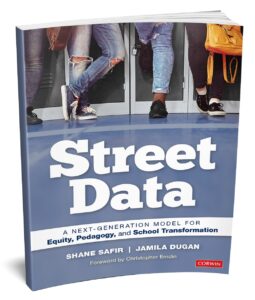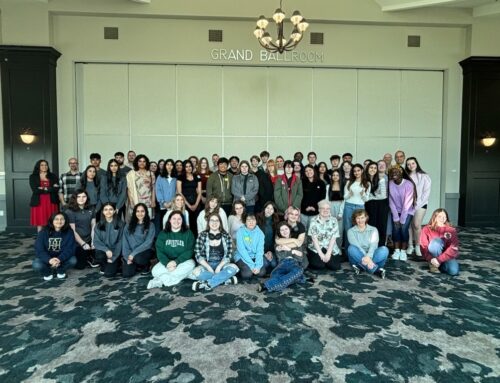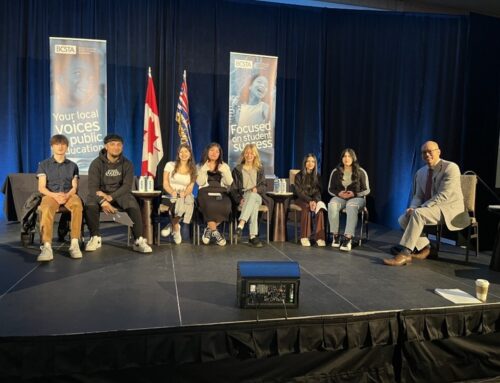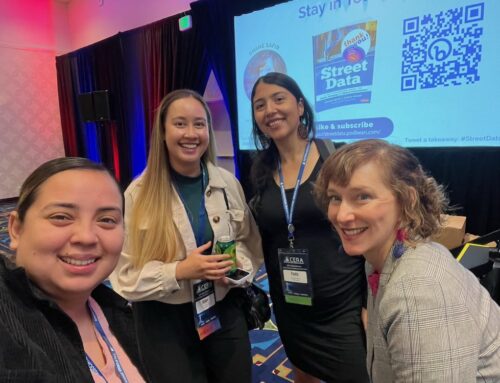About a month ago, I did my first sprint triathlon in Santa Cruz, California with my coparent Manny. This entailed a half-mile open water swim, a 12-mile bike course, and three-mile run. I trained, sort of, for a couple of months and was feeling pretty confident about everything except the open water. I have always loved swimming, but something about the combination of cold, murky, and possible sharks sent shivers up my spine.
At 9:30 a.m., the master of ceremonies blew a horn and dozens of women in wetsuits bolted out of the waiting area and flew headfirst into the ocean. As I tried to find a rhythm for my breath and strokes, I felt a rush of adrenaline. Arms and legs were flying all around me, and a thick wall of bubbles impaired my vision. About 50 yards in, I began to panic. My heart was racing as I poked my head up, looked behind me, and wondered, “Can I do this?”
Now, mind you, I am a fairly strong swimmer and had practiced this distance many times before the event. But in that moment, my primal brain took over and I doubted that I could keep going. Suddenly, a shadowy figure appeared to my left. It was a course monitor, a woman sitting on a surfboard, legs extended on either side and leaning toward me with concern.
“Are you okay?” she asked. “I’m just nervous,” I replied in a shaky voice. “You got this,” she said gently, yet firmly.
I can’t explain to you exactly what happened next, but I know that my brain chemistry shifted. I took a deep breath, put my head down, and began to relax into a stroke pattern that got me through that terrifying half-mile in less than 15 minutes. I was back in the game.
Since the event (which I did complete!), I’ve thought a lot about the impact of those three simple words: “You got this.” Here are a few messages I received in that moment, their ripple effects, and possible implications for teaching and learning.
“You are not alone.”
The first reassuring message I received was that I was not alone. The primal panic I felt may have stemmed from a fear of physical danger, but it was calmed by a sense of social connection. There was another human being, on a surfboard, looking out for me. I could turn inward and push myself to the edge of my comfort zone because someone was watching.
In the classroom, how often do our struggling learners check out because they feel alone? In my book, The Listening Leader, I acknowledge the presence of a dominant culture in schooling that tends to promote individualism and individual achievement over team success, independence and self‐reliance over interdependence, and competition over collaboration (page 69).
When we tell a student, “You got this,” we’re communicating: “I am invested in your success. In fact, our success is interdependent. You are a member of a community where you are seen and safe.” I got an inkling of that feeling when the course monitor reassured me in the roiling ocean waters.
“I believe in you.”
The anonymous surfboard woman also communicated that she believed in me! Perhaps she had seen me start the course with confident strokes before faltering, or perhaps she’d experienced this exact moment before with other first-time triathletes. It didn’t matter. What I felt in that moment was that someone believed I could do this. And that feeling was powerful and energizing. It calmed my nervous system and helped me access what I already knew: I could do this. The fact that another person had faith in me shifted me from paralysis into action.
How many of our students struggle to feel believed in? According to Californians for Justice, a phenomenal youth organizing group that I partner with, “The belief gap is the product of unequal expectations based on race and zip code. One out of three students in California schools cannot identify a single caring adult on campus, and 30 percent of African American and 22 percent of Latino students drop out.” It’s heartbreaking to me that children spend seven hours a day in an institution where they don’t feel that a single grown-up believes in them.
Imagine what would happen if we committed to make sure that every child can identify at least one adult on campus who believes in them. Imagine if we set an intention to sit alongside our struggling learners every time they faltered and affirmed, “You got this.”
“I’m not going to lower my standards for you just because you’re struggling.”
Finally, the surfboard stranger communicated that she wasn’t going to let me off the hook, even if I was scared and ready to give up. She held me accountable to my own goal and helped me grow at the edge of my comfort zone rather than opt out.
A pervasive problem in our schools is the pobrecito myth, a Spanish word that literally translates into “poor little one” and which I discuss in Chapter 5 of The Listening Leader. When educators feel sorry for students who are struggling academically or emotionally, they may lower their expectations rather than lifting the student up to meet those expectations. The simple phrase “You got this” rejects pity in favor of empowerment. It conveys that no matter how lost or self-doubting you may feel, no matter how many obstacles you face, I know you can do this.
The Ultimate Message: You Are Safe and We Are Connected
“You got this” just might be the same kind of game-changer in the classroom as it was for me in the open water. With these three words, we convey the values of connection and interdependence, and we communicate confidence and high expectations. I know that grit has had a long run in the education world, but here’s where I’ve come to: As important as grit and resilience may be, they do not trump the need for a loving adult.

 Enter your email here and get a free copy of the first chapter of Street Data!
Enter your email here and get a free copy of the first chapter of Street Data!



Leave A Comment
You must be logged in to post a comment.